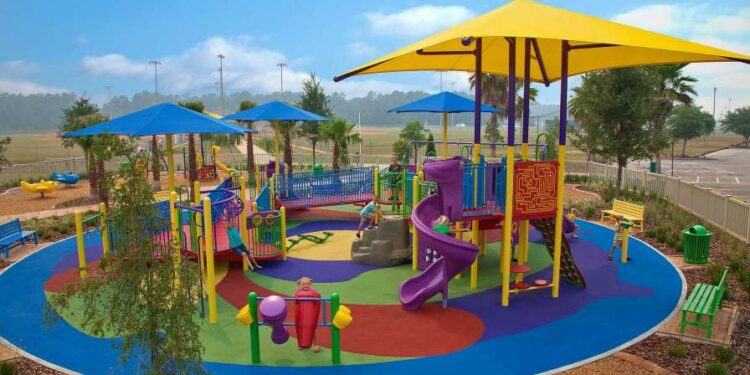Schoolyards and parks give children an opportunity to engage in free play and social interaction. Well-designed playgrounds become natural gathering places where kids can exercise both their minds and bodies. The fun and imaginative nature of these spaces can help naturally reserved children come out of their shells and engage with others. In a highly digitized world, many parents agree that outdoor play is more important now than ever before. Unfortunately, many children prefer to spend time indoors on digital devices that cater to short attention spans.
To remain relevant and exciting, today’s playgrounds need an upgrade. Any playground perceived as boring or outdated is unlikely to generate public interest. Whether you’re a school administrator or city council member, you may need to oversee plans for installing or upgrading local playgrounds. Here are five tips for choosing dynamic playground designs that enhance childhood experiences in schoolyards and parks.
1. Make Playground Safety a Top Priority
The skin-burning metal slides and child-flinging merry-go-rounds of yesteryear won’t cut it in today’s parks. Parents are unlikely to take their little ones to high-risk areas that could result in broken bones or first-degree burns. They want to know their kids can have fun in an environment that’s both entertaining and safe. When selecting playground equipment for a schoolyard or city park, safety should be a top priority.
If you live in a hot climate, plastic slides are a wiser choice than metal slides. If possible, place slides in shaded areas to prevent unintended burns. Further enhance safety by selecting soft playground surfaces such as rubber mulch, poured-in-place surfacing, and engineered wood fiber mulch. Be sure to place benches and other seating areas around the park perimeter so parents can easily monitor their children.
2. Make Parks Inclusive for Children of All Abilities
Families with children who have special needs often struggle to find inclusive schoolyard playgrounds and parks. When selecting or designing your park, try to make it inviting for kids of all ages and abilities. The families in your area will appreciate the effort taken to ensure children with disabilities can play alongside their peers.
There are many ways to make playgrounds more inclusive. You could start by installing wheelchair-friendly swings and wide ramps. You might also consider adding textures to the walls for visually impaired children. Kids with autism may respond well to quiet areas where they can retreat with their parents when playground noises become overwhelming.
3. Incorporate Interactive Elements
Traditional playground equipment helps kids stay physically active, but it doesn’t do much to stimulate their minds. You can help children think critically, collaborate, and learn how to problem-solve by installing interactive play equipment. Unlike traditional equipment, interactive play equipment entertains and challenges simultaneously.
Popular types of interactive equipment include floor games like hopscotch and checkers. Digital play panels can further stimulate the imagination and encourage active participation. Climbing walls, water play equipment, and weather-resistant musical instrument panels are some additional interactive playground favorites. You might consider polling your community members to see which interactive elements they would like to see in local playgrounds.
4. Create Themed Zones
Whether you’re designing a school or city park, you want to create an outdoor space that’s dynamic and interesting. Remember, you’re competing with highly entertaining video games and cartoons that keep a growing number of children indoors. You’ll need to step up your game if you want your park to successfully persuade children to come outdoors. One way to enhance the outdoor play experience and improve cognitive flexibility is to create themed zones in your park.
For example, you might include a fairy tale zone where castle-like structures and ride-on dragons immerse children in a world of make-believe. Or you could introduce a pirate-themed corner where kids can climb on nets or steer a ship-shaped playground across the sea. If you’re working with a tight budget, you don’t need to install anything too elaborate or expensive. Simply include a few themed visual elements and the children’s imaginations will do the rest.
5. Include Educational Elements
Playgrounds don’t have to be all fun and no learning. In fact, some of the most interesting play areas incorporate educational elements into their design. When children learn in a fun, stress-free environment, they’re more likely to enjoy the process. They may also find it easier to retain new information.
Modern playgrounds often offer educational elements to enhance learning. You might choose to install math panels where kids can race each other to solve equations. Or you could include a climbing wall with fossil-shaped protrusions to help children learn about paleontology. Some parks also incorporate picture panels illustrating how ants build underground colonies or how plants grow from seeds.
Communities need to encourage active outdoor play by prioritizing exciting, safe, and inclusive playgrounds. In a digital age, more kids are choosing to stay indoors playing video games or scrolling social media feeds. Unfortunately, too much screen time can lead to weight gain, depression, and a lack of social development. Help school kids develop physically, socially, and emotionally by providing safe outdoor play areas. Use these tips to design exciting, interactive playgrounds that generate community interest.





